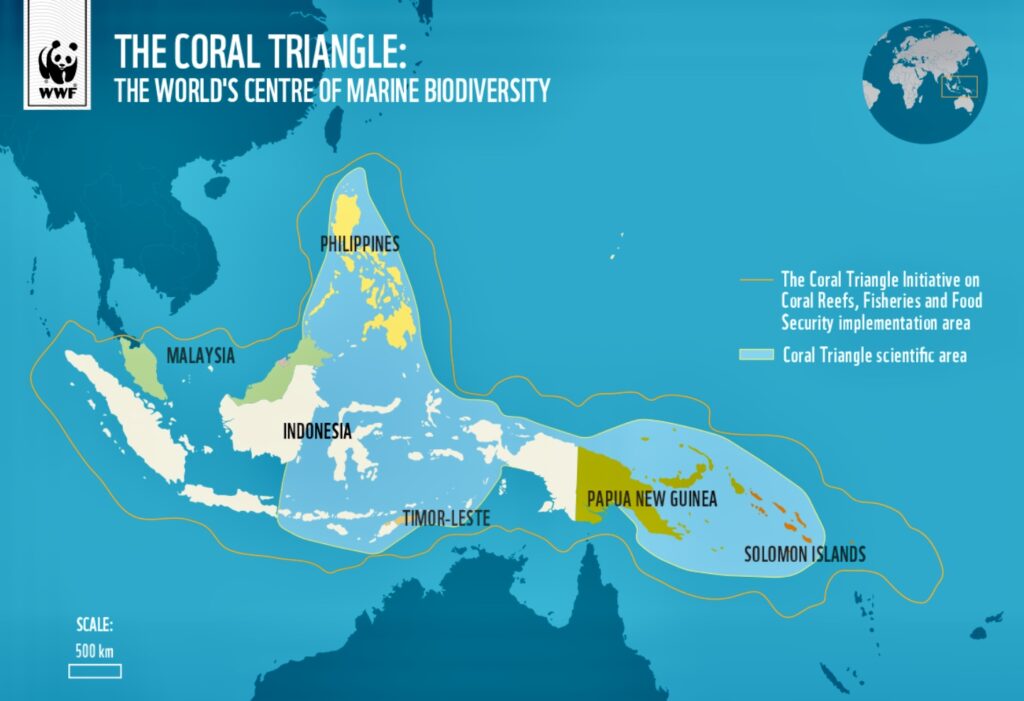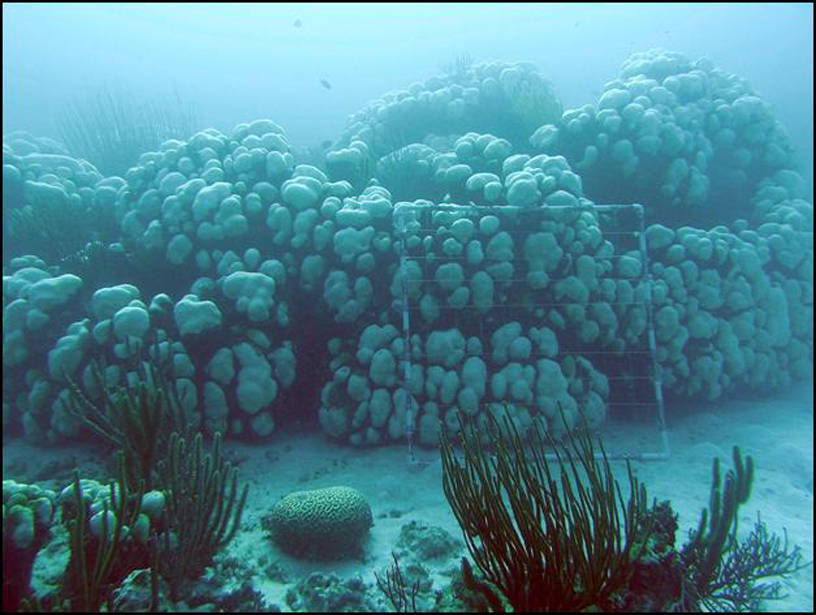Text by Henrylito D. Tacio
Photos from WWF and NOAA
If there’s Bermuda Triangle in the western part of the North Atlantic Ocean, there is Coral Triangle in the western part of the Pacific Ocean.
But while Bermuda Triangle has been known for the various disappearances of ships and planes, which have been attributed to the paranormal or activity by extraterrestrial beings, Coral Triangle is famous for its marine treasure.
If the Amazon is the symbol of the world’s rainforests, the Coral Triangle is touted to be the center of global marine diversity. In this region that’s half the size of the United States and passes through six countries, there are more marine species than anywhere else on the planet.
The region covers the exclusive economic zones of Indonesia, Malaysia, the Philippines, Papua New Guinea, Solomon Islands, and East Timor. It is considered as one of the three mega ecological complexes on earth, together with Congo Basin and the Amazon Rainforest.
Every year, on June 9, Coral Triangle Day is celebrated to raise awareness of ocean conservation and protection in the countries which are members of the Coral Triangle. It was first held as a regional interpretation of World Oceans Day in 2012. Since then, it is simultaneously celebrated by all Coral Triangle countries annually.
Numerous activities are being held during the Coral Triangle Day, which includes but is not limited to beach clean-ups, sustainable seafood dinners and exhibitions; bazaars; and beach parties, among others.

Coral Triangle 
Coral bleaching (Photo courtesy of NOAA)
What’s so special about the Coral Triangle?
For one, most of the coral reefs can be found in this region.
“The Coral Triangle occupies just 1.5% of the world’s total area, but represents 30% of the world’s coral reefs,” says the website earth.org. “The area, covering over 130,000 square kilometers, has nearly 600 species of reef-building corals – 75% of the world’s coral species.”
This means the region has the highest coral diversity in the world. “The epicenter of that coral diversity is found in the Bird’s Head Peninsula of Indonesian Papua, which hosts 574 species (95% of the Coral Triangle, and 72% of the world’s total),” states the World Wide Fund for Nature (WWF). “Within the Bird’s Head Peninsula, the Raja Ampat archipelago is the world’s coral diversity bull’s eye with 553 species.”
Not only that. “The Coral Triangle has 15 regionally endemic coral species (species found nowhere else in the world), and shares 41 regional endemic species with Asia,” says the WWF.
Because of its huge coral reef areas and diversity, it contains 37% (2,228) of the world’s coral reef fish species (6,000) and 56% of the coral reef fishes in the Indo-Pacific region (4,050).
At least 8% (235 species) of the coral reef fishes in the Coral Triangle are endemic or locally restricted species. Within the Coral Triangle, four areas have particularly high levels of endemism: the Lesser Sunda Islands, Papua New Guinea-Solomon Islands, Bird’s Head Peninsula, and the Central Philippines.
“Healthy reefs act as natural barriers that soften the blow from typhoons, storm-generated waves and tsunamis,” earth.org says.
A study done in 2018 showed that damage to coastal communities in the Coral Triangle caused by flooding would nearly double with the ecologically fragile coral reefs.
“Additionally, without the reefs, Malaysia, Indonesia and the Philippines would see the costs of flooding events tripled; the reefs that encircle these countries could save, on average, more than US$400 million each year.”
The Coral Triangle is not only known for its coral reefs but also for its marine turtles. There are only eight marine turtles known to man, and six of them can be found in this region.
The Philippines, for instance, is home to five of them: Green Sea (known in the science world as Chelonia mydas), Hawksbill (Eretmochelys imbricata), Loggerhead (Caretta caretta), Olive Ridley (Lepidochelys olivacea), and Leatherback (Dermocheyls coriacea).
There are several other marine species swimming in its waters. “Whales, dolphins, porpoises, dugongs and whale shark feed, breed and migrate in these waters,” earth.org says.
The Coral Triangle also supports large populations of commercially important tuna: over 120 million people live in the region and rely on it for food, income, and protection from storms.
“Tuna spawning and nursery grounds support a multi-billon dollar industry, while the tourism industry associated with the Coral Triangle is valued at over US$12 billion annually,” earth.org reports.
Despite their importance and the economic opportunities the region brings, Coral Triangle is not spared from destruction and environmental woes.
For one, there are issues of overfishing and the employment of destructive fishing methods.
“Overfishing and methods of harvesting fish and other resources are unsustainable at current levels and place this vitally important region at risk of breakdown,” earth.org points out.
Dynamite fishing and the use of cyanide are the two destructive fishing methods being employed in the region.
“Blasting destroys over 200 square feet of coral reef at a time, while cyanide stuns fish without killing them, leaving them unable to move and easy to catch,” earth.org says. “Bycatching is also an issue, where non-target fish species are caught.”
Earth.org further states: “When large, predatory fish are sustainably caught, the reef can rebound. Often though, the area’s largest predators are pulled from the reef in high numbers, shrinking their populations and allowing destructive fish populations to weaken the coral reef ecosystem.”
The rising ocean temperatures are also threatening the region’s coral reefs. “Coral reefs cannot survive if the water keeps warming; corals rely on algae living inside them to supply them with food,” earth.org explains. “The algae, which give the coral its colors, die if the water gets too hot. The loss of this algae leaves the coral bleached.”
Additionally, plastic pollution is threatening the reefs. “Marine animals consume small pieces of plastic, and these plastics sometimes act as vectors for disease, spreading contagions like ‘white syndrome’ from sick to healthy corals,” earth.org says.
The Philippines, being part of the Coral Triangle, also plays an important role. For one, more than 500 species of coral and 2,000 species of fish live in the waters of the Philippine islands, according to coraltrianglecenter.org.
About 10% of the world’s marine protected areas – more than 500 – are in the Philippines. Of these, less than 200 have been assessed as “effectively managed.”
Marine protection has a long history in the Philippines; tribal customs dating back hundreds of years prescribed marine resource use. As early as the 1870s, collection areas for milkfish (locally known as bangus) were regulated. The Hundred Islands National Park is considered to be the first marine park in Southeast Asia.
Donsol, at south of Luzon Island, is the most significant whale shark interaction site in the world. Whale sharks are the world’s biggest fish; they are considered vulnerable and are protected in the country.
The waters of Davao Gulf are regarded as one of the most diverse cetacean habitats in the country, being home to at least ten species of toothed whales and dolphins such as sperm whales and beaked whales. In addition, whale sharks and dugongs are seen frequently.

